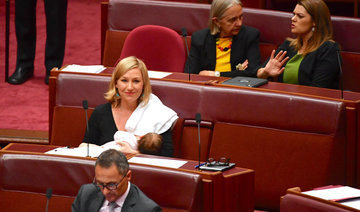SYDNEY: Australian anti-immigration politician Pauline Hanson caused a furor Thursday when she entered the Senate wearing a full burqa, earning a blistering rebuke from the country’s top lawyer for the “appalling” stunt.
Hanson wore the garment in the chamber to highlight what she said were the security issues it posed, linking it to terrorism as fellow senators heckled her.
“Will you work to ban the burqa in Australia in light of what is happening with national security?” she said after whipping off the garment to question Attorney-General George Brandis.
She added: “Terrorism is a true threat to our country, many Australians are in fear of it.”
Brandis said his conservative government had no such plans, warning Hanson she risked offending the Muslim community by wearing a burka when she was not a follower of Islam.
“To ridicule that community, to drive it into a corner, to mock its religious garments is an appalling thing to do, and I would ask you to reflect on what you have done,” he said.
Brandis, his voice cracking with emotion, also said that being a strict adherent Muslim, such as those who wear the burka, was “absolutely consistent” with being a law-abiding citizen.
“We have about half-a-million Australians in this country of the Islamic faith and the vast majority of them are law-abiding, good Australians,” he said.
Brandis’ remarks prompted a standing ovation from his political opponents in the Labor and Greens parties.
Independent Sen. Derryn Hinch labelled Hanson’s conduct “disgusting.”
“Pauline Hanson mocked the religion of some Australians ... she made a mockery of an honorable place (the Senate),” he told Sky News.
Labor senator Sam Dastyari accused Hanson of stoking extremism in a poorly timed bid for “a cheap headline.”
“In the same week that we saw white nationalism rear its ugly head in the country of our closest ally — in that week a stunt like this gets pulled in the Australian Senate,” he said.
“It is hurtful, it is offensive, it is wrong,“
Hanson first gained prominence in the 1990s, when she warned Australia was in danger of being “swamped by Asians.”
After a 12-year hiatus from politics she returned in 2014, this time targeting Muslims and was elected to the Senate two years later as leader of the right-wing One Nation party.
In her first speech after returning to parliament, she said Islam was “a culture and ideology that is incompatible with our own.”
Hanson was unrepentant after her latest stunt, telling commercial radio: “Is it extreme? Yes. Is it getting my message across? I hope so.”
Politician rebuked for wearing burqa in Australian Senate
Politician rebuked for wearing burqa in Australian Senate

Oman’s MSX leads GCC equity markets in 2025: Kamco Invest

RIYADH: Oman’s Muscat Securities Market emerged as the best-performing index in the Gulf Cooperation Council region in 2025, rising 28.2 percent year on year, according to an analysis by Kamco Invest.
In its latest report, the financial firm said the MSX 30 Index closed the year at 5,866.8 points, marking one of the strongest annual performances among GCC markets.
According to the analysis, the index reached its annual peak at 5,985.66 points in mid-December, while its lowest level was 4,223.83 points in early April, reflecting a 38.9 percent recovery from the year’s trough.
Developing a robust capital market ecosystem remains crucial for GCC countries as they pursue economic diversification efforts to reduce dependence on oil revenues.
“The aggregate MSCI GCC index reported a gain of 1.6 percent during the year despite largely positive performance at the country level. At the exchange level, Oman witnessed the biggest gains during the year with a double-digit surge of 28.2 percent,” said Kamco Invest.
The report added that Boursa Kuwait ranked as the second-best-performing market in the GCC, posting gains of 21.2 percent during the year.
The Abu Dhabi Securities Exchange advanced 6.1 percent, while the Dubai Financial Market climbed 17.2 percent, supported by selective strength in real estate and services stocks.
The Qatar Exchange recorded a marginal increase of 1.8 percent, while the Bahrain Bourse rose 4.1 percent in 2025.
Despite a 12.8 percent decline, Saudi Arabia dominated regional listings activity during 2025.
The Kingdom saw 13 companies debut on the Tadawul All Share Index, along with two transfers from the parallel Nomu market to the main market. In addition, 28 companies were listed on the Nomu market.
Flynas was Saudi Arabia’s largest initial public offering in 2025, raising SR4.1 billion ($1.1 billion) in one of the region’s biggest aviation listings.
Other notable IPOs during the year included Umm Al Qura for Development & Construction Co., Specialized Medical Co., Derayah Financial Co., and Dar Al Majed Real Estate Co.
“At the sector level, the yearly performance (in the region) was skewed toward decliners with over 30 percent fall in Utilities, Insurance and Consumer Durable indices. On the gainers side, Telecom, Banks and Diversified Financials indices showed double gains that offset the overall weakness,” added Kamco Invest.













